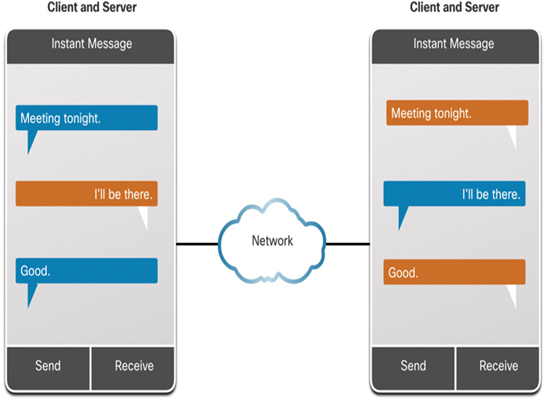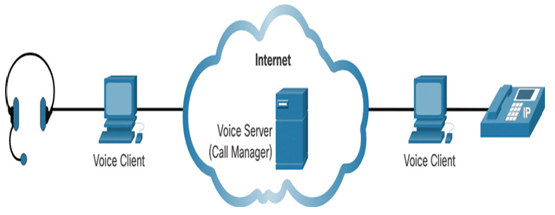Text messaging, shown in Figure 16-11, is one of the most popular communication tools in use today. In addition, text messaging software is built into many online applications, smart phone apps, and social media sites.

Figure 16-11 Text Messaging
Both clients can simultaneously send and receive messages.
Text messages may also be called instant messages, direct messages, private messages, and chat messages. Text messaging enables users to communicate or chat over the internet in real-time. Text messaging services on a computer are usually accessed through a web-based client that is integrated into a social media or information sharing site. These clients usually only connect to other users of the same site.
There are also a number of standalone text message clients such as Cisco Webex Teams, Microsoft Teams, WhatsApp, Facebook Messenger, and many others. These applications are available for a wide variety of operating systems and devices. A mobile version is typically offered. In addition to text messages, these clients support the transfer of documents, video, music, and audio files.
Making telephone calls over the internet is becoming increasingly popular. An internet telephony client uses peer-to-peer technology similar to that used by instant messaging, as shown in Figure 16-12. IP telephony makes use of Voice over IP (VoIP) technology, which converts analog voice signals into digital data. The voice data is encapsulated into IP packets which carry the phone call through the network.

Figure 16-12 VoIP Phone Call Example
When the IP phone software has been installed, the user selects a unique name. This is so that calls can be received from other users. Speakers and a microphone, built-in or separate, are required. A headset is frequently plugged into the computer to serve as a phone.
Calls are made to other users of the same service on the internet, by selecting the username from a list. A call to a regular telephone (landline or cell phone) requires using a gateway to access the Public Switched Telephone Network (PSTN). Depending on the service, there may be charges associated with this type of call. The protocols and destination ports used by internet telephony applications can vary based on the software.
Check Your Understanding – Email and Messaging (16.7.5)
Refer to the online course to complete this activity.
Application Layer Services Summary (16.8)
The following is a summary of each topic in the chapter and some questions for your reflection.
